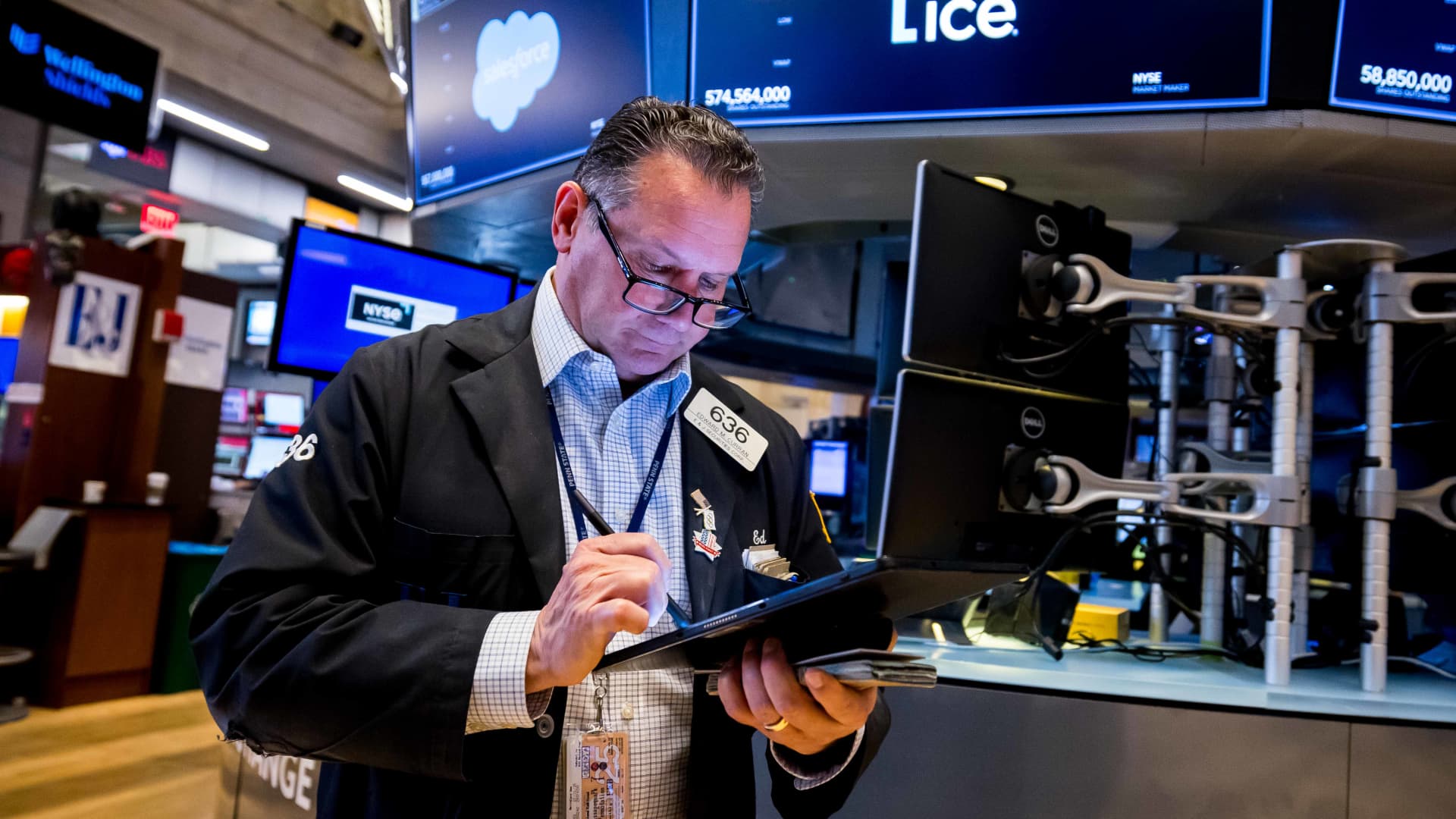It probably has felt worse than it looks. A not-quite-5% shakeout from a record high in the S & P 500 is purely routine in magnitude and in some respects came right on time. It was never a secret that late February can be a rough patch for stocks. And the fine print on all the bullish writeups for 2025 dutifully noted that post-election years often withhold their rewards in the early going and that equity returns after consecutive annual gains of 20% or more tend to moderate. Here’s a picture from Strategas Research of the S & P 500 since Election Day 2024, against the average performance after elections since Dwight Eisenhower was first voted into the White House. Even the sharp turn in market leadership toward “safer” sectors in recent weeks maps tightly to the historical record, as this Ned Davis Research study of the relative performance of defensives (staples, healthcare, utilities and telecom) makes clear. Yet as much as the late-February flop scans as perfectly normal on paper, the manner and speed of the setback, the way it challenges some core consensus assumptions and the cacophonous policy-news soundscape have arguably made the action more unsettling. Money has rushed from the crowded and popular areas (tech, industrials) to the spurned and disliked (staples, healthcare). Foreign stocks have outpaced the U.S., confounding a collective “U.S. exceptionalism” trade. Bonds have rallied in the face of the “higher-for-longer” crowd. The key indexes fell through a trap door right from the latest all-time high set on Feb. 19, at least until the final minutes of Friday’s session, when a huge cluster of buy orders set for the month-end close met a shaken and mildly oversold tape to drive a quick 1.5% levitation in the S & P 500. (A mechanical rebalancing effect like this qualifies as buying all the same, and the prices still count on the big scoreboard. The quicksilver closing rally hit just as the Nasdaq 100 was encountering important trend support, too. Yet it would be surprising if the market didn’t feel the need to test the territory covered in those final moments for the presence of new high-conviction buyers.) What’s causing the selling? As is usually the case when a bull market falters a bit, there are multiple likely suspects acting at once. We entered the year riding elevated valuations and high expectations for an ideal setup of above-trend economic performance that would draw further strength from loosening Federal Reserve policy and a purported “growth-friendly” administration. All this, just as earnings growth would broaden out and allow the majority of stocks to catch up. Meantime, retail investors were pumping adrenaline into a new category of moonshot tech themes, crypto plays and Trump-adjacent meme names. None of this has been decisively refuted or permanently canceled, but the plot lines have run into complications. There is a mild but meaningful economic growth scare underway. The Citi U.S. Economic Surprise Index has rolled over into the negative zone (meaning macro data is on average falling short of forecasts). The consumer seems to have stepped back at the start of the year. While the drop in Atlanta Fed GDPNow tracking for the first quarter into negative territory on Friday is mostly about pulled-forward imports and inventories (factors likely to reverse), the Treasury market surely is registering a deceleration. The two-year Treasury yield sank back below 4% for the first time in several months, beckoning the Fed to prioritize growth risks over steady inflation. This all has prevented the core cyclical parts of the market from fully supporting the indexes on days when the dominant mega-cap Nasdaq leaders have sagged. The pervasive calls for a “broadening market” have in some respects been met; the Magnificent 7 as a group is down almost 6% year to date with the rest of the index up a few percent. Yet a bare majority of S & P 500 stocks are in an uptrend and key macro bellwethers such as small-caps and industrials are back below Election Day levels. Bank stocks and credit spreads are so far holding up reasonably well, though have not been immune. John Kolovos, chief technical market strategist at Macro Risk Advisors, says, “Financials, the last main holdout within cyclicals and tied to credit conditions, remain strong, while staples is overbought within a downtrend, and Industrials are oversold within an uptrend. We ‘should,’ therefore, see risk sentiment begin to improve if a) equities are not to fall into a correction or worse, b) a policy mistake results in worsening credit conditions, and 3) the shroud of uncertainty from DC doesn’t cripple the economy.” Earnings as reported have hit all the usual marks, three-quarters of companies beating estimates. The decline in full-year S & P 500 profit consensus so far this year has been 1%, a pretty normal pace of moderation, according to FactSet. Yet shares of both companies beating and missing expectations are being treated less generously than usual. And Bespoke Investment Group notes that the percentage of companies raising guidance is the lowest since Covid and is half the percentage of those cutting their outlook. Investors losing confidence? This all speaks to a general lack of conviction in the pacing and extent of policy moves spanning tariffs, immigration restrictions, sudden Federal agency cutbacks and geopolitical reorientation. I usually discount the “confidence” and “uncertainty” factors as direct market drivers. The world is inherently uncertain at all times, and when people perceive it as such it means this reality is being recognized and the market is in the prices of pricing it in. Yet at a time like this, when “rising animal spirits” was a top-three bullish talking point entering the year, the psychology can’t fully be dismissed. The intense policy noise, like someone turning the dial of an old car radio through all the stations constantly, has dampened some ordinary investors’ mood to an historic degree. This look from BTIG shows net bulls in the American Association of Individual Investors survey falling toward deep bear-market readings even with the S & P 500 just off a record. Odd and hard to interpret, given that it doesn’t fit perfectly with real-money sentiment gauges. Options activity, ETF flows have reflected a more upbeat view, though with some cooling off. Deutsche Bank’s composite investor positioning measure fell hard to the dead-neutral zone at week’s end, a constructive though not decisive development. Four weeks ago, I noted here that clockwork sector rotation and ferocious retail-investor bid were the two forces propping up the tape. The gears of the rotation, as noted, have been slipping somewhat. On the retail enthusiasm, I suggested, “be watchful of excesses developing and be aware that this crowd can exhaust itself buying dips in the same old favorites. Is something like this happening in Nvidia? The Street flow trackers have noted that small traders have been persistent bidders for Nvidia shares and options on each break, even as fund managers have gradually lightened up in the stock.” Nvidia rallied a quick 10% from there and then gave it all up and a bit more despite healthy, if not dazzling, quarterly results. The more overheated retail playthings have had it worse as traders both prompted and reacted to the sharp reversal in momentum leaders. The bellwether pair I’ve tracked, Robinhood and Palantir, like Nvidia ripped into mid-February and have since broken hard, the former 25% off its high and the latter down 33%. An index from Goldman Sachs of “high retail sentiment” stocks gave up in eight trading sessions the 20% gain it had built up over the prior three months. .SPX 1Y mountain S & P 500, 1-year MRA’s Kolovos has been holding to an upside S & P 500 target of 6600, but more loosely and with a tighter focus on the interim hazards of a breakdown in the market’s once-elegant rotational dynamics. After last week, he saw “further evidence of an equity tape that is not only stuck in purgatory but one that may still need to shake hands with the devil at the 200-day moving average before ascending.” That level is just 2% beneath Friday’s low and 3.9% below where it closed. Market shakeouts are about testing risk tolerances, forcing a rethink of unexamined premises and, at times, chastening the arrogant. A good deal of this work has been underway for a few weeks, taking the benchmark S & P 500 back to a spot first reached more than four months ago, which is sometimes enough of a reset, but not always.
Stock market enters March facing economic jitters and intense policy noise that’s denting confidence


